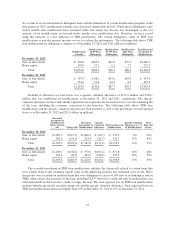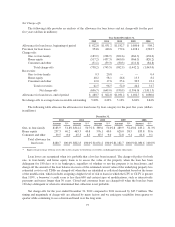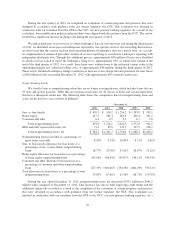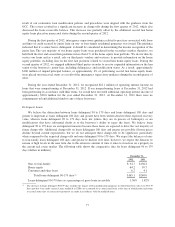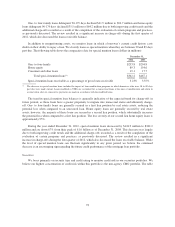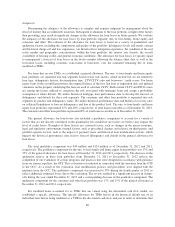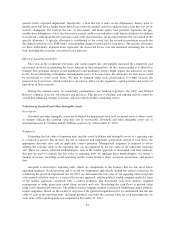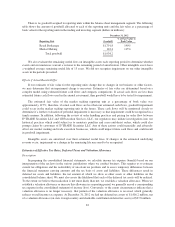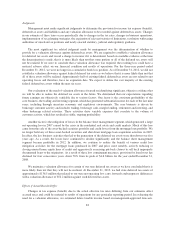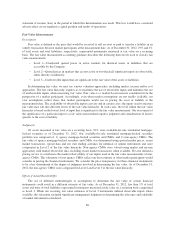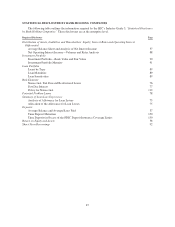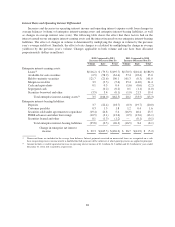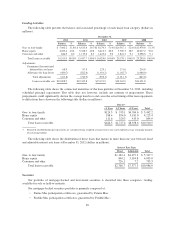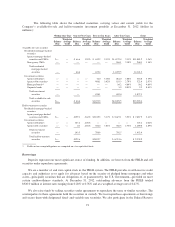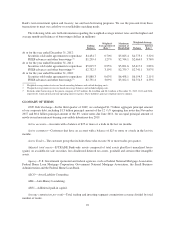eTrade 2012 Annual Report Download - page 87
Download and view the complete annual report
Please find page 87 of the 2012 eTrade annual report below. You can navigate through the pages in the report by either clicking on the pages listed below, or by using the keyword search tool below to find specific information within the annual report.This process required significant judgment by management about matters that are by nature uncertain. If future
events differ significantly from our current forecasts, a valuation allowance may need to be established, which
could have a material adverse effect on our financial condition and results of operations.
Classification and Valuation of Certain Investments
Description
The classification of an investment determines its accounting treatment. We classify our investments in
securities as trading, available-for-sale or held-to-maturity. Trading securities are carried at fair value and both
unrealized and realized gains and losses are recognized in the consolidated statement of income (loss). Securities
classified as available-for-sale are carried at fair value with unrealized gains and losses included in accumulated
other comprehensive loss, net of tax. Held-to-maturity securities are carried at amortized cost based on our
positive intent and ability to hold these securities to maturity. Declines in fair value for available-for-sale and
held-to-maturity debt securities that we believe to be other-than-temporary are included in the consolidated
statement of income (loss) in the net impairment line item. As of December 31, 2012, the available-for-sale and
held-to-maturity securities portfolios consisted of debt securities, the majority of which were agency residential
mortgage-backed securities.
Available-for-sale and held-to-maturity securities that have unrealized or unrecognized losses (impaired
securities) are evaluated for OTTI at each balance sheet date. We consider OTTI for an available-for-sale or held-
to-maturity debt security to have occurred if one of the following conditions are met: we intend to sell the
impaired debt security as of the balance sheet date; it is more likely than not that we will be required to sell the
impaired debt security before recovery of the security’s amortized cost basis; or we do not expect to recover the
entire amortized cost basis of the security. If we intend to sell an impaired debt security or if it is more likely than
not that we will be required to sell the impaired debt security before recovery of the security’s amortized cost
basis, we will recognize OTTI in earnings equal to the entire difference between the security’s amortized cost
basis and the security’s fair value. For impaired debt securities that we do not intend to sell and it is not more
likely than not that we will be required to sell before recovery of the security’s amortized cost basis, if we do not
expect to recover the entire amortized cost basis of the securities, we will separate OTTI into two components: 1)
the amount related to credit loss, recognized in earnings; and 2) the noncredit portion of OTTI, recognized
through other comprehensive income (loss). For the year ended December 31, 2012, we recognized $16.9 million
of net impairment on certain securities in the non-agency CMO portfolio.
Judgments
Our evaluation of whether we intend to sell an impaired debt security considers whether management has
decided to sell the security as of the balance sheet date. Our evaluation of whether it is more likely than not that
we will be required to sell an impaired debt security before recovery of the security’s amortized cost basis
considers the likelihood of sales that involve legal, regulatory or operational requirements. For impaired debt
securities that we do not intend to sell and it is not more likely than not that we will be required to sell before
recovery of the security’s amortized cost basis, we use both qualitative and quantitative valuation measures to
evaluate whether we expect to recover the entire amortized cost basis of the security. We consider all available
information relevant to the collectibility of the security, including credit enhancements, security structure,
vintage, credit ratings and other relevant collateral characteristics.
Effects if Actual Results Differ
Determining if a security has OTTI is complex and requires judgment by management about circumstances
that are inherently uncertain. Subsequent evaluations of these securities, in light of factors then prevailing, may
result in additional OTTI in future periods. If all available-for-sale and held-to-maturity securities with fair
values lower than amortized cost as of December 31, 2012 were other-than-temporarily impaired and the gross
OTTI was recorded through earnings, we would have recorded a pre-tax loss of $54.7 million.
84


